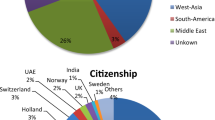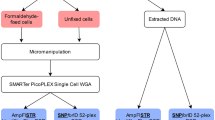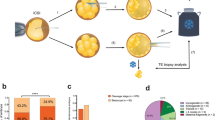Abstract
Recently, preimplantation genetic diagnosis (PGD) has been considered for several indications beyond its original purpose, not only to test embryos for genetic disease but also to select embryos for a nondisease trait, such as specific human leukocyte antigen (HLA) genotypes, related to immune compatibility with an existing affected child in need of a haematopoetic stem cell (HSC) transplant. We have optimized an indirect single-cell HLA typing protocol based on a multiplex fluorescent polymerase chain reaction (PCR) of short tandem repeat (STR) markers scattered throughout the HLA complex. The assay was clinically applied in 60 cycles from 45 couples. A conclusive HLA-matching diagnosis was achieved in 483/530 (91.1%) of the embryos tested. In total, 74 (15.3%) embryos revealed an HLA match with the affected siblings, 55 (11.4%) of which resulted unaffected and 46 (9.5%) have been transferred to the patients. Nine pregnancies were achieved, five healthy HLA-matched children have already been delivered and cord blood HSCs, were transplanted to three affected siblings, resulting in a successful haematopoietic reconstruction.
Similar content being viewed by others
Introduction
Preimplantation genetic diagnosis (PGD) has become an important option for couples at risk of conceiving affected children with single gene disorders. PGD has recently been used in combination with human leukocyte antigen (HLA) matching, allowing selection and transfer of unaffected embryos which also have a close HLA match with those of an existing affected child.1, 2, 3, 4, 5 In such cases, PGD was used not only to avoid the birth of affected children but also to conceive healthy children, who may be potential HLA-identical donors of haematopoietic stem cells (HSC) for transplantation in siblings with a life-threatening disorder. At delivery, HSC from the newborn umbilical cord blood (UCB) are collected and used for the haematopoietic reconstruction of the affected sibling.
Technically, PGD for HLA typing is a difficult procedure due to the extreme polymorphism of the HLA region. Moreover, taking into account the complexity of the region (presence of a large number of loci and alleles), the use of a direct HLA typing approach would require standardization of a polymerase chain reaction (PCR) protocol specific for each family, making it time consuming and unfeasible.
This paper describes the optimization of a flexible indirect single-cell HLA typing assay, applicable to a wide spectrum of possible HLA genotypes. The approach involves testing of single blastomeres by fluorescent multiplex PCR analysis of polymorphic short tandem repeat (STR) markers, scattered throughout the HLA complex, obtaining a ‘fingerprint’ of the entire HLA region.
Materials and methods
STR markers primer design
All the primers for the selected STR markers were designed in our Centre using Primer Express™ (Applied Biosystems, USA) software. The primer sequence of 29 of these STRs and their clinical application, included in a protocol involving a minisequencing-based HLA typing procedure, have been described previously.4 An additional set of 21 STRs was also included in the present study to achieve a fine mapping of the extended HLA complex. The primer sequence of these markers is shown in Table 1.
Informativity testing on individual couples
Informativity testing of STR markers was performed in family members as described previously.4 A panel of 50 different STR markers was studied to ensure a sufficient informativity in all families. Informativity was also evaluated for STR markers linked to the gene regions, which were involved by mutation, used to avoid a possible misdiagnosis due to the well-known allele drop-out (ADO) phenomena, and for STR markers used to determine the copy number of chromosomes 21, 18, 13, X and Y, applied for patients of advanced reproductive age.
IVF and multiplex PCR
Cleavage stage embryos were obtained using a standard IVF procedure, as described elsewhere.6, 7 After embryo biopsy, each blastomere was transferred into a sterile 0.2 ml PCR tube containing 5 μl of alkaline lysis buffer (200 mmol/l KOH, 50 mmol/l DTT) and cells were lysed by incubation at 65°C for 10 min. The alkaline lysis buffer was then neutralized by the addition of 5 μl of neutralization buffer (900 mmol/l Tris-HCl, 300 mmol/l KCl, 200 mmol/l HCl).
A nested multiplex PCR protocol was used to coamplify all the selected loci. The first round PCR contained the external primers for the amplification of the informative HLA STR markers, the gene regions involved by mutation, STR markers linked to these regions for ADO detection and those used for detection of aneuploidies in patients of advanced reproductive age. Separate second round PCR reactions for each locus were then performed using 2 μl of the primary PCR products. PCR conditions used were reported previously.4
Fluorescent PCR products were analysed by 20 min of capillary electrophoresis on an automatic DNA sequencer ABI Prism 3100™ (Applied Biosystems). Mutation analysis was performed using the minisequencing method, as described elsewhere.8
Results
The procedure was applied to 60 PGD cycles performed for 45 couples (Table 2). The results of 17 of these cycles for 15 couples, obtained using a strategy involving a minisequencing-based HLA typing procedure combined with HLA STRs haplotyping, were previously reported.4
A total of 530 embryos were biopsied, involving analysis of 922 blastomeres, in 848 (92.0%) of which a successful amplification was obtained. The amplification efficiency of the individual STR markers on blastomeres ranged from 92.2 to 100%, with an overall amplification rate of 98.2% (data not shown).
ADO of at least one STR marker was detected on 155/805 blastomeres, involving 45 different markers for a total of 366 ADO occurrences (data not shown). The ADO rates of the individual markers varied from 0.0 to 10.8% (3.4% on average).
A reliable HLA haplotype was obtained in 848/848 (100%) of the blastomeres with positive PCR results. Testing for chromosome 6 copy number revealed 47 (8.9%) embryos with aneuploidies, including four (0.8%) trisomies and 43 (8.1%) monosomies, which affected the HLA-matching diagnosis for these embryos, leading to a conclusive diagnosis in only 483/530 embryos (91.1%).
Recombination was found in 23 (4.8%) embryos, five (1.0%) of which were originally unaffected and HLA compatible, but were not considered for transfer because of recombination, which determined a partial incompatibility of the HLA region (Table 2).
In total, 74 (15.3%) embryos were HLA matched with the affected siblings, 55 (11.4%) of which were in an unaffected genotype. Only 46 (9.5%) embryos were transferred to the patients in 30 of the 60 cycles performed (1.5 on the average) and seven clinical pregnancies were achieved (23.3% per transfer). One pregnancy is still ongoing, while one twin and three singleton pregnancies resulted in the birth of five HLA-matched healthy children (Table 2).
An example of preimplantation HLA-matching procedure using STR haplotyping, in combination with PGD for β-thalassaemia, is shown in Figure 1a.
(a) Preimplantation HLA matching in combination with PGD for β-thalassaemia, resulting in the birth of two twins, HLA matched with the affected sibling. Specific haplotypes were determined by genomic DNA analysis of HLA STR markers and Beta globin (HBB) gene-linked markers from father, mother (upper panel) and affected child (lower panel-left side, black square). Informative STR markers are ordered from telomere (top) to centromere (bottom). The numbers in STR markers represent the size of PCR products in base pair. Paternally and maternally derived HLA haplotypes matched to the affected child and STR alleles linked to the paternal and maternal mutations are represented in boldface. Examples of different results of HBB mutation analysis and HLA haplotyping from biopsied blastomeres are shown in the lower panel. The HLA identity of the embryos with the affected sibling has been ascertained evaluating the inheritance of the matching haplotypes. Embryos 1 (carrier) and 8 (affected) represent HLA non identical embryos. Embryo 3 was diagnosed as normal, and embryo 7 as carrier, HLA matched with the affected sibling. ET=embryo transfer. (b) Example of recombination detection in a preimplantation HLA-matching cycle for a sporadic form of Diamond–Blackfan anemia (DBA). Embryo 1 shows a single recombination occurrence in maternal haplotype, between markers D6S105 and MIB (square); in embryo 6, initially appearing to be HLA matched with the affected sibling, a double recombination event in paternal haplotype, between markers D6S1683 and D6S265 (square), is evident.
Discussion
At present, allogenic HSC transplantation represents the only curative treatment for restoring normal haematopoiesis in severe cases of neoplastic or congenital disorders affecting the haematopoietic and/or the immune system. HLA-identical siblings provide the best chance to achieve a successful transplantation for the recipient.9, 10 Therefore, if no HLA-identical donor is available in the family, an increasing number of couples with a child affected by a haematopoietic disorder are considering the use of IVF and PGD techniques for therapeutic intent.
A preimplantation HLA-matching assay, involving haplotyping of the HLA region by analysing different polymorphic STR markers located along the HLA complex, was optimized and clinically applied in 45 couples. Using this approach, the HLA region was indirectly typed by segregation analysis of the STR alleles and the HLA identity of the embryos with the affected sibling was ascertained evaluating the inheritance of the matching haplotypes. As previously demonstrated,4 in fact, no discordance was found between the direct HLA genotyping and STR haplotyping, indicating the latter as a reliable diagnostic tool for indirect HLA-matching evaluation.
The strategy presented here enables the selection of HLA-matched embryos for any genotype combination, without the need to develop a specific experimental design for each couple. As a consequence, a substantial shortening of the preliminary phase can be achieved. Another important advantage is the possibility of detecting recombination events between HLA genes. Recombination occurrences, if not detected, could strongly affect the accuracy of the HLA-matching procedure because embryos might be erroneously diagnosed as HLA identical. The importance of detecting recombination is highlighted in Figure 1b. In embryo 6, initially appearing to be HLA matched with the affected sibling, the occurrence of a double recombination event was detected only by using a consistent number of STR markers. Hence, the reliability of the procedure is strongly correlated with the number of STR markers used for HLA haplotyping.
The introduced approach appeared to be highly accurate in the selection of HLA-matched embryos for transfer, as confirmed by prenatal diagnosis of subsequent pregnancies and blood testing of the newborn. Overall, seven unaffected HLA-matched clinical pregnancies have been established, resulting in the birth of five healthy children, representing one of the most extensive experience in the field and complementing other similar experiences.2, 3, 5 Presently, UCB stem cells collected from the above children have already been transplanted to the affected siblings of three couples, resulting in a successful haematopoietic reconstruction for all the patients. These preliminary results, combined with the recently reported successful HSC transplantations,5, 11, 12 are very encouraging and suggest that preimplantation HLA matching could represent an acceptable alternative for the achievement of a successful treatment in children affected by severe congenital or acquired bone marrow disorders, in the absence of a compatible related donor.
In conclusion, the reliability and robustness of the STR HLA haplotyping protocol makes this method an attractive strategy for preimplantation HLA matching. The present results confirm the feasibility of the procedure, providing a realistic option for couples to have a child, who would also serve as a UCB donor for an existing affected sibling in need of HSC transplantation without any other feasible medical alternative.
References
Verlinsky Y, Rechitsky S, Schoolcraft W, Strom C, Kuliev A : Preimplantation diagnosis for Fanconi anemia combined with HLA matching. JAMA 2001; 285: 3130–3133.
Van de Velde H, Georgiou I, De Rycke M et al: Novel universal approach for preimplantation genetic diagnosis of β-thalassemia in combination with HLA matching of embryos. Hum Reprod 2004; 19: 700–708.
Rechitsky S, Kuliev A, Tur-Kaspa I, Morris R, Verlinsky Y : Preimplantation genetic diagnosis with HLA matching. Reprod Biomed Online 2004; 9: 210–221.
Fiorentino F, Biricik A, Karadayi H et al: Development and clinical application of a strategy for preimplantation genetic diagnosis of single gene disorders combined with HLA matching. Mol Hum Reprod 2004; 10: 445–460.
Verlinsky Y, Rechitsky S, Sharapova T, Morris R, Taranissi M, Kuliev A : Preimplantation HLA testing. JAMA 2004; 291: 2079–2085.
Kahraman S, Kumtepe Y, Sertyel S et al: Pronuclear morphology scoring and chromosomal status of embryos in severe male infertility. Hum Reprod 2002; 17: 3193–3200.
Kahraman S, Karlikaya G, Sertyel S, Karadayi H, Findikli N, Oncu N : Clinical aspects of preimplantation genetic diagnosis for single gene disorderscombined with HLA typing. Reprod Biomed Online 2004; 9: 529–532.
Fiorentino F, Magli MC, Podini D et al: The minisequencing method: an alternative strategy for preimplantation genetic diagnosis of single gene disorders. Mol Hum Reprod 2003; 9: 399–410.
Lucarelli G, Andreani M, Angelucci E0 : The cure of thalassemia by bone marrow transplantation. Blood Rev 2002; 16: 81–85.
La Nasa G, Giardini C, Argiolu F et al: Unrelated donor bone marrow transplantation for thalassemia: the effect of extended haplotypes. Blood 2002; 99: 4350–4356.
Grewal SS, Kahn JP, MacMillan ML, Ramsay NK, Wagner JE : Successful hematopoietic stem cell transplantation for Fanconi anemia from an unaffected HLA-genotype-identical sibling selected using preimplantation genetic diagnosis. Blood 2004; 103: 1147–1151.
Bielorai B, Hughes MR, Auerbach AD et al: Successful umbilical cord blood transplantation for Fanconi anemia using preimplantation genetic diagnosis for HLA-matched donor. Am J Hematol 2004; 77: 397–399.
Acknowledgements
We thank Nello Vitale and Luca Brardinoni for technical assistance in the preclinical work up of PGD cases, and Dr Vincenzo Trengia for his important contribution in bringing some PGD cases to clinical application. Furthermore, we are grateful to Paula Franke, for proof-reading the English in this manuscript.
Author information
Authors and Affiliations
Corresponding author
Rights and permissions
About this article
Cite this article
Fiorentino, F., Kahraman, S., Karadayi, H. et al. Short tandem repeats haplotyping of the HLA region in preimplantation HLA matching. Eur J Hum Genet 13, 953–958 (2005). https://doi.org/10.1038/sj.ejhg.5201435
Received:
Revised:
Accepted:
Published:
Issue Date:
DOI: https://doi.org/10.1038/sj.ejhg.5201435
Keywords
This article is cited by
-
Karyomapping in preimplantation genetic testing for β-thalassemia combined with HLA matching: a systematic summary
Journal of Assisted Reproduction and Genetics (2019)
-
Karyomapping—a comprehensive means of simultaneous monogenic and cytogenetic PGD: comparison with standard approaches in real time for Marfan syndrome
Journal of Assisted Reproduction and Genetics (2015)
-
Meiotic recombinations within major histocompatibility complex of human embryos
Immunogenetics (2012)
-
Quality management system in PGD/PGS: now is the time
Journal of Assisted Reproduction and Genetics (2009)
-
Preimplantation HLA haplotyping using tri-, tetra-, and pentanucleotide short tandem repeats for HLA matching
Journal of Assisted Reproduction and Genetics (2008)




